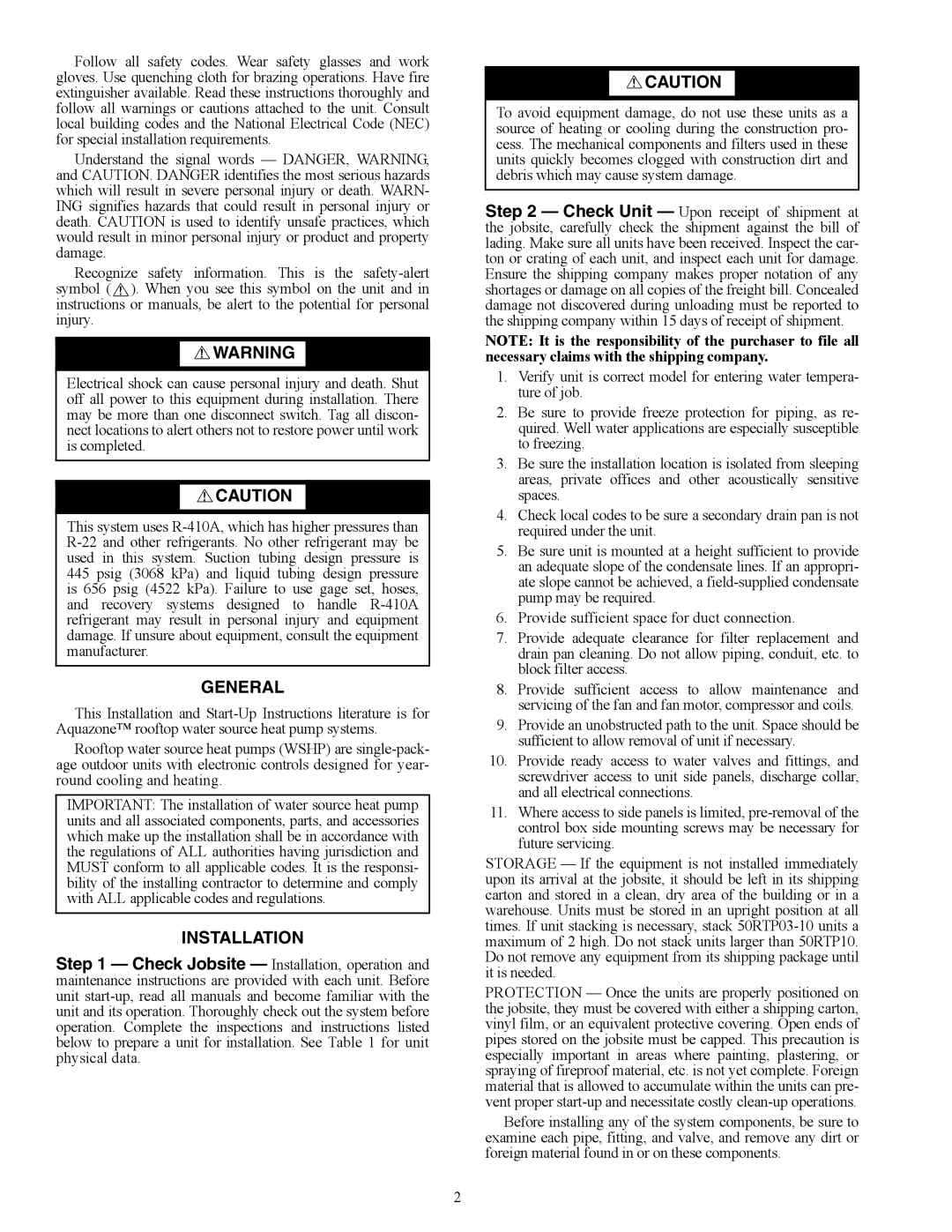
Follow all safety codes. Wear safety glasses and work gloves. Use quenching cloth for brazing operations. Have fire extinguisher available. Read these instructions thoroughly and follow all warnings or cautions attached to the unit. Consult local building codes and the National Electrical Code (NEC) for special installation requirements.
Understand the signal words — DANGER, WARNING, and CAUTION. DANGER identifies the most serious hazards which will result in severe personal injury or death. WARN- ING signifies hazards that could result in personal injury or death. CAUTION is used to identify unsafe practices, which would result in minor personal injury or product and property damage.
Recognize safety information. This is the
![]() WARNING
WARNING
Electrical shock can cause personal injury and death. Shut off all power to this equipment during installation. There may be more than one disconnect switch. Tag all discon- nect locations to alert others not to restore power until work is completed.
![]() CAUTION
CAUTION
This system uses
GENERAL
This Installation and
Rooftop water source heat pumps (WSHP) are
IMPORTANT: The installation of water source heat pump units and all associated components, parts, and accessories which make up the installation shall be in accordance with the regulations of ALL authorities having jurisdiction and MUST conform to all applicable codes. It is the responsi- bility of the installing contractor to determine and comply with ALL applicable codes and regulations.
INSTALLATION
Step 1 — Check Jobsite — Installation, operation and maintenance instructions are provided with each unit. Before unit
![]() CAUTION
CAUTION
To avoid equipment damage, do not use these units as a source of heating or cooling during the construction pro- cess. The mechanical components and filters used in these units quickly becomes clogged with construction dirt and debris which may cause system damage.
Step 2 — Check Unit — Upon receipt of shipment at the jobsite, carefully check the shipment against the bill of lading. Make sure all units have been received. Inspect the car- ton or crating of each unit, and inspect each unit for damage. Ensure the shipping company makes proper notation of any shortages or damage on all copies of the freight bill. Concealed damage not discovered during unloading must be reported to the shipping company within 15 days of receipt of shipment.
NOTE: It is the responsibility of the purchaser to file all necessary claims with the shipping company.
1.Verify unit is correct model for entering water tempera- ture of job.
2.Be sure to provide freeze protection for piping, as re- quired. Well water applications are especially susceptible to freezing.
3.Be sure the installation location is isolated from sleeping areas, private offices and other acoustically sensitive spaces.
4.Check local codes to be sure a secondary drain pan is not required under the unit.
5.Be sure unit is mounted at a height sufficient to provide an adequate slope of the condensate lines. If an appropri- ate slope cannot be achieved, a
6.Provide sufficient space for duct connection.
7.Provide adequate clearance for filter replacement and drain pan cleaning. Do not allow piping, conduit, etc. to block filter access.
8.Provide sufficient access to allow maintenance and servicing of the fan and fan motor, compressor and coils.
9.Provide an unobstructed path to the unit. Space should be sufficient to allow removal of unit if necessary.
10.Provide ready access to water valves and fittings, and screwdriver access to unit side panels, discharge collar, and all electrical connections.
11.Where access to side panels is limited,
STORAGE — If the equipment is not installed immediately upon its arrival at the jobsite, it should be left in its shipping carton and stored in a clean, dry area of the building or in a warehouse. Units must be stored in an upright position at all times. If unit stacking is necessary, stack
PROTECTION — Once the units are properly positioned on the jobsite, they must be covered with either a shipping carton, vinyl film, or an equivalent protective covering. Open ends of pipes stored on the jobsite must be capped. This precaution is especially important in areas where painting, plastering, or spraying of fireproof material, etc. is not yet complete. Foreign material that is allowed to accumulate within the units can pre- vent proper
Before installing any of the system components, be sure to examine each pipe, fitting, and valve, and remove any dirt or foreign material found in or on these components.
2
